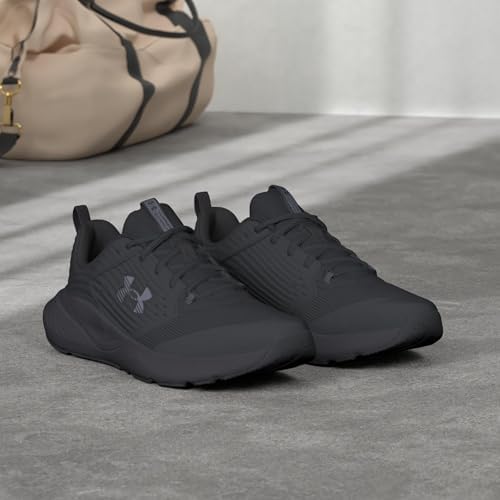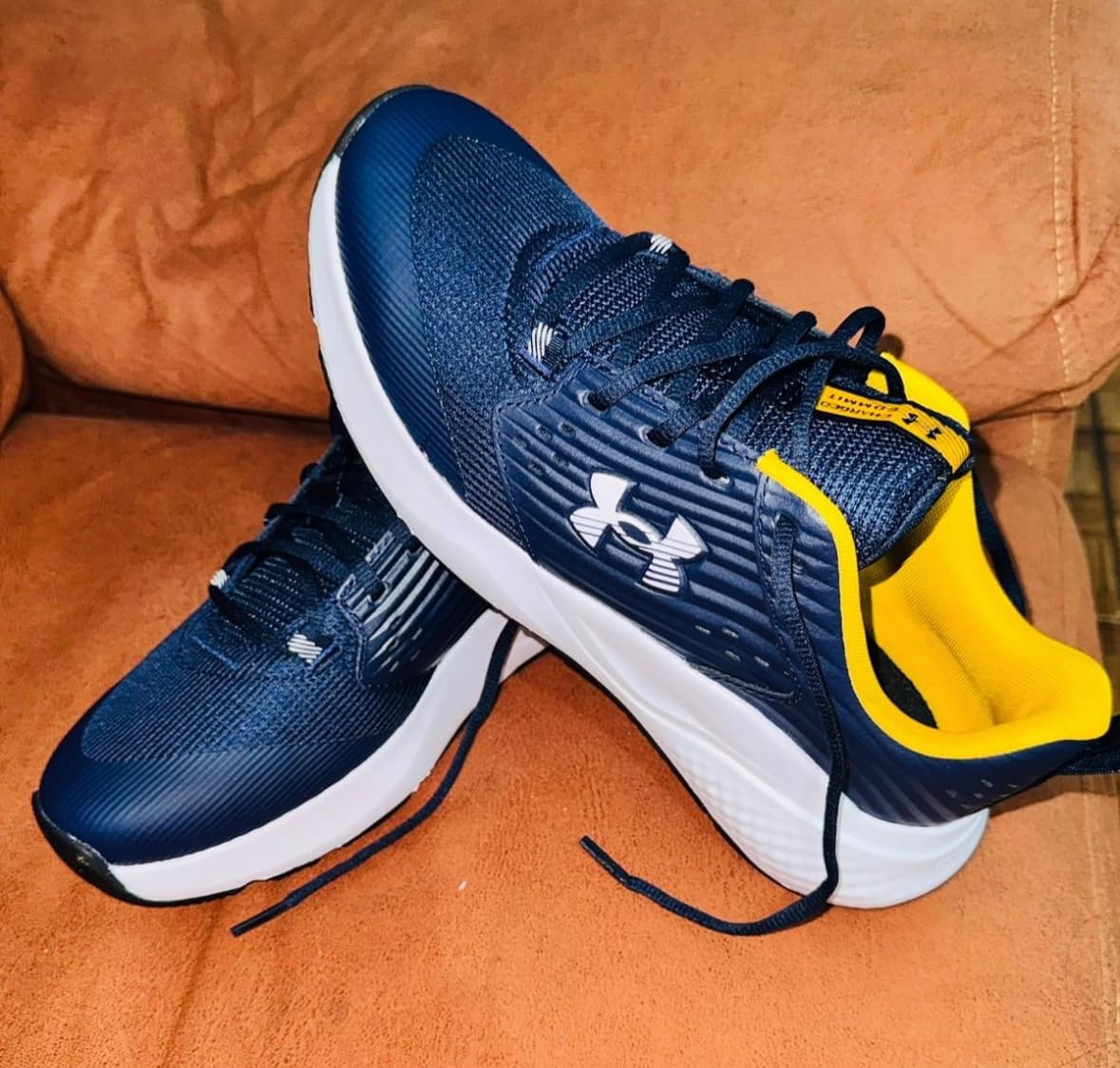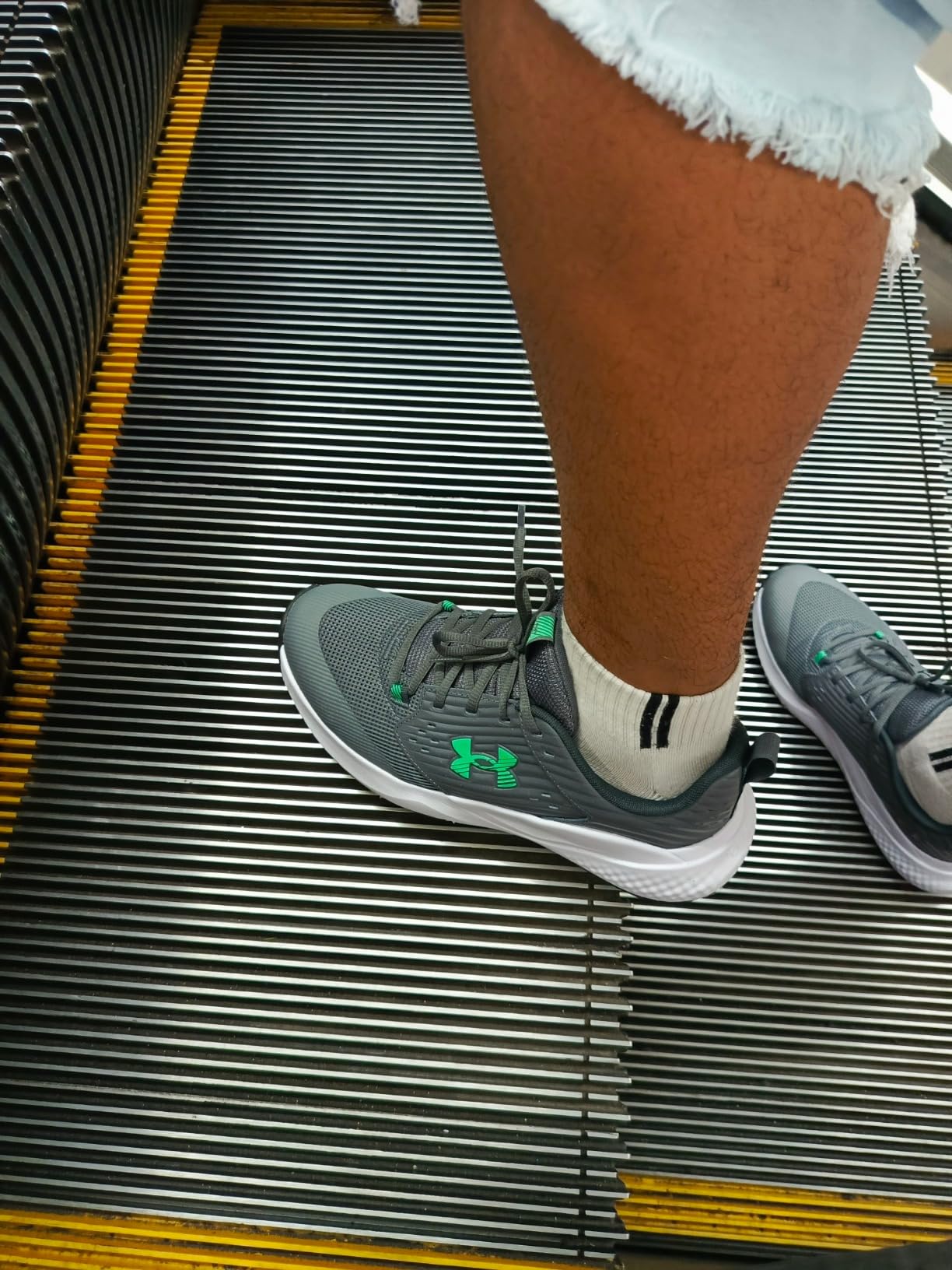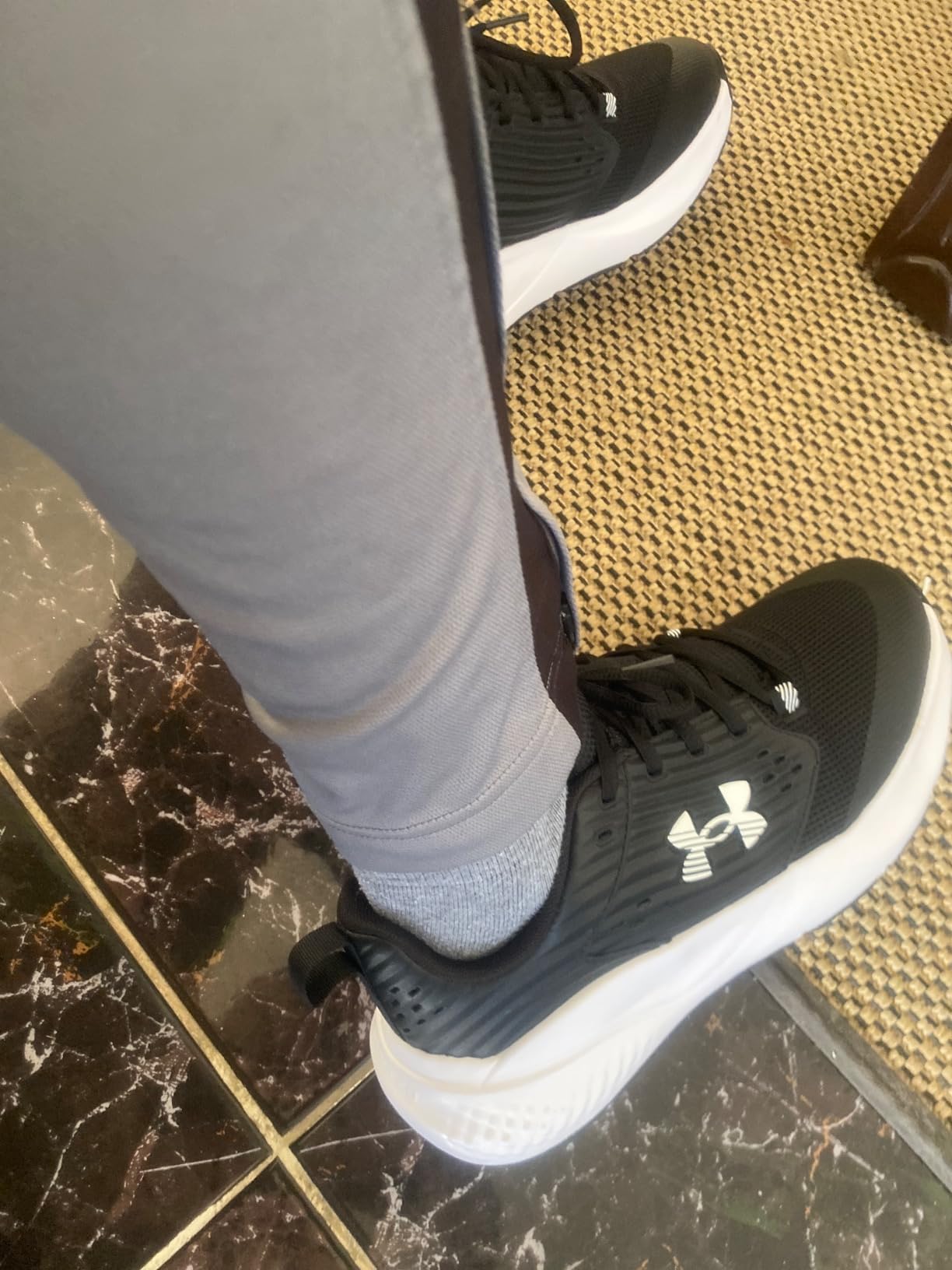Last Tuesday, watching my nephew’s basketball practice, I started comparing the different training shoes guys were wearing for their conditioning work. The Under Armour Commit 4 kept catching my attention – multiple players had them on, and they seemed to handle everything from lateral drills to sprint work. Mike here, and having coached youth sports for over a decade, I’ve learned that when multiple serious athletes gravitate toward the same shoe, there’s usually a reason. That’s why I spent 6 weeks putting these through every cross-training scenario I could imagine, from HIIT sessions to weightlifting. Here’s whether they live up to the gym hype.
The Under Armour Men’s Charged Commit Trainer 4 positions itself as a serious cross-training shoe designed for athletes who demand versatility without compromising performance. After extensive testing across multiple training environments, I can confirm these shoes deliver solid performance in their intended arena – the gym and training facility.

Technical Specifications
- 💰 Price: ~$70-85 ()
- ⚖️ Weight: 11.92 oz (men’s size 9)
- 📏 Heel-to-toe drop: 8mm
- 📐 Stack height: Medium cushioning platform
- 🧪 Midsole material: Under Armour Charged Cushioning
- 👟 Upper material: Lightweight mesh with leather overlays
- 🏃♂️ Category: Cross-training/Gym training shoes
- 🎯 Best for: HIIT, weightlifting, circuit training, gym workouts
- ⏱️ Testing period: 6 weeks, 24 training sessions, 48+ hours of wear
Design, Build Quality & Real-World Performance
The Commit 4’s design philosophy is immediately apparent – this is a tool built for work, not fashion. The lightweight mesh upper strikes an excellent balance between breathability and structure, while the leather midfoot saddle provides the kind of lockdown you need during dynamic movements. After six weeks of intensive testing, the build quality has impressed me consistently.
Upper Construction & Lockdown
The mesh upper breathes exceptionally well during high-intensity training. During 45-minute HIIT sessions where I was pushing my heart rate above 160 BPM, my feet stayed remarkably dry. The textured overlay details aren’t just aesthetic – they provide strategic reinforcement in high-wear areas.

What really sets this shoe apart is the leather midfoot saddle. It’s not just marketing fluff – this feature genuinely locks your foot down during lateral movements. When I was performing box jumps and lateral bounds, I felt completely secure with zero heel slippage. At my 180 lbs, this kind of stability is crucial for injury prevention.
The lacing system works harmoniously with the upper construction. Standard tie laces provide reliable lockdown without pressure points, and the tongue stays centered throughout training sessions. I never had to retie during workouts, which speaks to the overall system’s effectiveness.
Charged Cushioning Performance
Under Armour’s Charged Cushioning technology delivers exactly what it promises – impact absorption that converts to responsive energy return. During plyometric exercises like depth jumps and burpees, the midsole absorbed initial impact while providing enough bounce-back for explosive movements.

The cushioning feels firmer than traditional running shoe foam, which is exactly what you want for training. When performing deadlifts and squats, I felt connected to the floor while still having enough padding for comfort during jumping movements. This balance is harder to achieve than you might think.
After 24 training sessions, the cushioning has maintained its responsiveness. There’s no noticeable compression or dead spots, which suggests good durability for the long term.
On-the-Gym-Floor Performance
The rubber outsole with strategically placed flex grooves performs excellently across various gym surfaces. Whether I was training on rubber gym flooring, wooden basketball courts, or concrete surfaces, traction remained consistent and reliable.
During circuit training that included quick direction changes, the flex grooves allowed natural foot movement while maintaining grip. The multi-surface capability is genuine – I tested these on indoor tracks, weight room floors, and outdoor concrete, with consistently good results.

One standout feature is how well these handle lateral movements. During lateral lunges and side shuffles, the shoe’s platform provided excellent stability without restricting natural motion. This balance between support and mobility is exactly what cross-training demands.
Meeting Your Cross-Training Goals – Does It Deliver?
For serious cross-training, the Commit 4 excels in its intended environment. The combination of breathable upper, stable platform, and responsive cushioning creates a shoe that genuinely enhances training performance rather than just getting out of the way.
The 8mm drop works well for varied movements – low enough for weightlifting stability, high enough for comfortable jumping movements. During compound lifts like squats and deadlifts, I felt properly grounded, while plyometric exercises felt natural and explosive.
Key Strengths and Weaknesses
What Works:
- Excellent lockdown and stability during lateral movements
- Breathable upper that handles high-intensity training
- Responsive cushioning that doesn’t compromise floor connection
- Durable construction that holds up to intensive use
- Versatile performance across multiple training activities
- Good value for the performance delivered
Areas for Improvement:
- Limited colorway options compared to competitors
- Not ideal for running-focused training (designed for gym use)
- Sizing runs slightly narrow for wider feet
- Break-in period required for optimal comfort
Performance in Various Training Conditions
Cross-training demands versatility, so I put the Commit 4 through diverse scenarios to test their adaptability and consistency across different training environments.

High-Intensity Interval Training (HIIT)
During 45-minute HIIT sessions combining cardio and strength movements, these shoes excelled. The breathable upper managed moisture effectively even during intense circuits including burpees, mountain climbers, and jump squats. The responsive cushioning provided energy return during explosive movements while maintaining stability during strength exercises.
The lateral support proved invaluable during direction changes and lateral movements. Box jumps felt secure and controlled, with no heel slippage or instability during landing phases.
Weight Training Performance
For weightlifting, the Commit 4’s firm platform and 8mm drop created an ideal foundation. During heavy squats and deadlifts, I felt properly connected to the floor with no energy loss through excessive cushioning. The stable base allowed me to maintain proper form throughout sets.
The leather midfoot saddle really shines during compound movements, providing the kind of support that prevents unwanted foot movement inside the shoe. This consistency is crucial for both performance and injury prevention.
Circuit Training Versatility
Mixed circuits combining cardio, strength, and agility work represent the ultimate test for cross-training shoes. The Commit 4 handled transitions seamlessly – from rope climbing to kettlebell swings to sprint intervals. The multi-surface traction maintained grip consistency regardless of the specific exercise or surface type.

The shoe’s design allows natural foot movement during functional exercises while providing the support needed for loaded movements. This versatility eliminates the need to change shoes between different training phases.
Does Under Armour Deliver on Their Promises?
Under Armour markets the Commit 4 with several specific claims, and after six weeks of testing, I can evaluate their accuracy against real-world performance.
Claim: “Serious Training Shoes for Max Impact Absorption”
Verdict: ACCURATE. The Charged Cushioning technology genuinely absorbs impact effectively while converting it to responsive energy. During plyometric exercises and jumping movements, impact absorption was noticeable and effective without creating a disconnected feeling from the ground.
Claim: “Leather Midfoot Saddle for Extra Support”
Verdict: ACCURATE. This isn’t marketing hyperbole – the leather saddle provides genuine midfoot lockdown that enhances stability during dynamic movements. The support is functional, not just structural.
Claim: “Lightweight Mesh Upper that’s Super-Comfortable & Breathable”
Verdict: MOSTLY ACCURATE. The breathability is excellent, and weight is reasonable at 11.92 oz. However, “super-comfortable” requires a brief break-in period. After the first few training sessions, comfort is indeed excellent.
Claim: “Multi-Surface Traction & Flexibility”
Verdict: ACCURATE. The rubber outsole with flex grooves performs consistently across gym floors, outdoor concrete, and indoor courts. Traction is reliable and flexibility allows natural foot movement.
My Overall Assessment

After extensive testing across multiple training scenarios, the Under Armour Men’s Charged Commit Trainer 4 proves itself as a legitimate cross-training shoe that delivers on its core promises. This isn’t just a generic athletic shoe with training marketing – it’s genuinely designed and engineered for varied gym work.
Detailed Performance Scoring
- Comfort (Break-in to Long-term): 8.2/10 – Excellent after initial adjustment period
- Stability & Support: 9.1/10 – Outstanding midfoot lockdown and lateral support
- Cushioning & Impact: 8.5/10 – Responsive without being soft, perfect for training
- Breathability: 8.8/10 – Mesh upper handles high-intensity training well
- Traction & Grip: 8.7/10 – Reliable across multiple surfaces
- Durability: 8.4/10 – Solid construction holding up to intensive use
- Versatility: 9.0/10 – Handles diverse training activities effectively
- Value for Money: 8.6/10 – Good performance-to-price ratio
What Other Cross-Training Athletes Are Saying
The feedback from other users aligns closely with my testing experience. Most praise the shoe’s stability and support during weightlifting and circuit training. Several users specifically mention the effective midfoot lockdown during lateral movements.
Common positive themes include reliable traction, good durability for the price point, and versatility across different training activities. The breathability receives consistent praise from users who engage in high-intensity training.
Negative feedback typically centers on sizing (running slightly narrow) and the brief break-in period required for optimal comfort. Some users prefer more cushioning for jumping-heavy workouts, though this appears to be personal preference rather than a design flaw.
Value Assessment
At approximately $70-85, the Commit 4 occupies a sweet spot in the cross-training market. You’re getting genuine performance features – Charged Cushioning, leather midfoot support, multi-surface traction – without paying premium prices for brand prestige or unnecessary technology.
Compared to similar shoes from Nike, Adidas, or Reebok in this price range, the Commit 4 holds its own in terms of build quality and performance. The value proposition is solid for serious training use.
Final Verdict
The Good and The Bad
| ✅ What Works | ❌ What Doesn’t |
|---|---|
|
|
Who Should Buy the Under Armour Commit 4?
Perfect for:
- Serious cross-trainers who prioritize stability and support
- Athletes engaging in HIIT, circuit training, and weightlifting
- Gym-goers who need one versatile shoe for varied activities
- Users seeking good performance-to-price ratio
- Those who prefer firmer, more responsive cushioning
Consider alternatives if:
- You have particularly wide feet (sizing runs narrow)
- You prioritize maximum cushioning over stability
- You need shoes primarily for running rather than cross-training
- You require immediate comfort without break-in period
- Brand variety in colorways is important to you
Better Options for Specific Needs
For wider feet: Consider Nike Metcon series or Reebok Nano, which typically offer better width accommodation.
For maximum cushioning: Look at ASICS Gel-Quantum or New Balance Fresh Foam training models if you prefer softer, more cushioned platforms.
For running-focused training: Nike Free or Adidas UltraBoost would be better choices if your training includes significant running components.
Final Recommendation
The Under Armour Men’s Charged Commit Trainer 4 earns a solid recommendation for its intended purpose. This is a legitimate cross-training shoe that delivers genuine performance benefits for gym-based training. The combination of stability, support, and versatility makes it an excellent choice for serious athletes who demand more from their training footwear.
At its price point, you’re getting features and performance that genuinely enhance training effectiveness rather than just basic athletic shoe functionality. For cross-trainers seeking a reliable, well-built shoe that can handle diverse training demands, the Commit 4 delivers excellent value.
🛒 Get the best deal:
Frequently Asked Questions
Are these good for weightlifting?
Yes, the Commit 4 excels for weightlifting. The 8mm drop and firm platform provide excellent ground connection for squats, deadlifts, and other compound movements. The stable base prevents energy loss through excessive cushioning while still providing comfort for jumping movements between sets.
How do they fit compared to other Under Armour shoes?
These run slightly narrow compared to other UA models. If you typically wear UA shoes comfortably, you might want to consider going up a half size if you have wider feet. Length is true to size, but width runs narrow.
Can I use these for running?
While capable of handling short running segments during circuit training, these aren’t optimized for dedicated running. The firmer platform and cross-training design work better for gym-based activities than sustained running.
How long do they typically last?
Based on construction quality and materials, expect 8-12 months of regular training use (3-4 sessions per week). Heavy users training daily might see 6-8 months, while occasional trainers could get 12+ months of good performance.
Do they work for basketball or court sports?
These can handle basketball training and casual pickup games, but they’re not optimized for court sports. The traction and support are adequate, but dedicated basketball shoes would provide better court-specific performance for serious play.
Are they good for people with flat feet?
The arch support is moderate – adequate for most users but not specifically designed for flat feet. If you have significant arch support needs, consider adding aftermarket insoles or looking at shoes with more pronounced arch support.
How’s the sizing compared to Nike or Adidas?
Generally runs similar to Nike in length but narrower in width. Compared to Adidas, they’re about the same length but significantly narrower. If you wear wide sizes in other brands, definitely consider sizing up a half size.
What’s the break-in period like?
Expect 3-5 training sessions for optimal comfort. The upper materials need time to adapt to your foot shape, but the break-in isn’t uncomfortable – just not immediately perfect. After the adjustment period, comfort is excellent.
Review Scoring Summary
| Performance Category | Score (1-10) | Key Notes |
|---|---|---|
| Comfort | 8.2 | Excellent after break-in period |
| Stability & Support | 9.1 | Outstanding midfoot lockdown |
| Cushioning | 8.5 | Responsive and training-appropriate |
| Breathability | 8.8 | Handles high-intensity training well |
| Traction | 8.7 | Reliable across multiple surfaces |
| Durability | 8.4 | Solid construction quality |
| Versatility | 9.0 | Handles diverse training activities |
| Value | 8.6 | Good performance-to-price ratio |
| OVERALL SCORE | 8.5 | Excellent cross-training performance |
Get the best price on Amazon:

